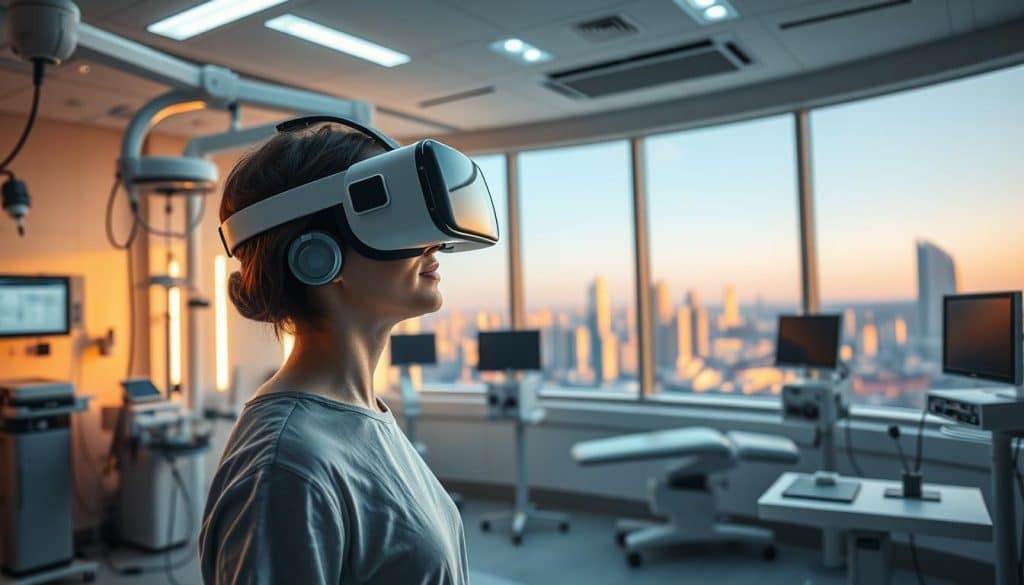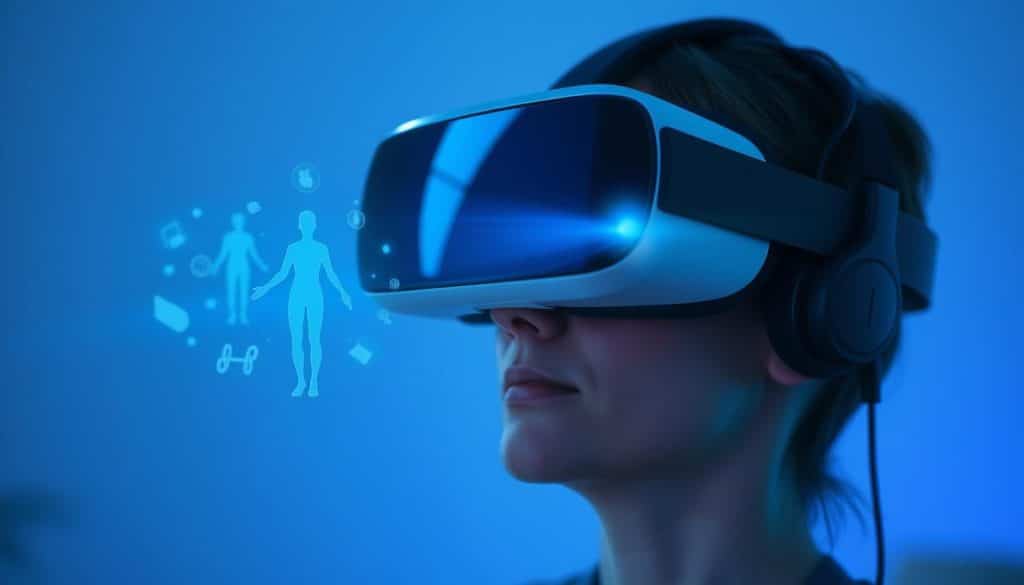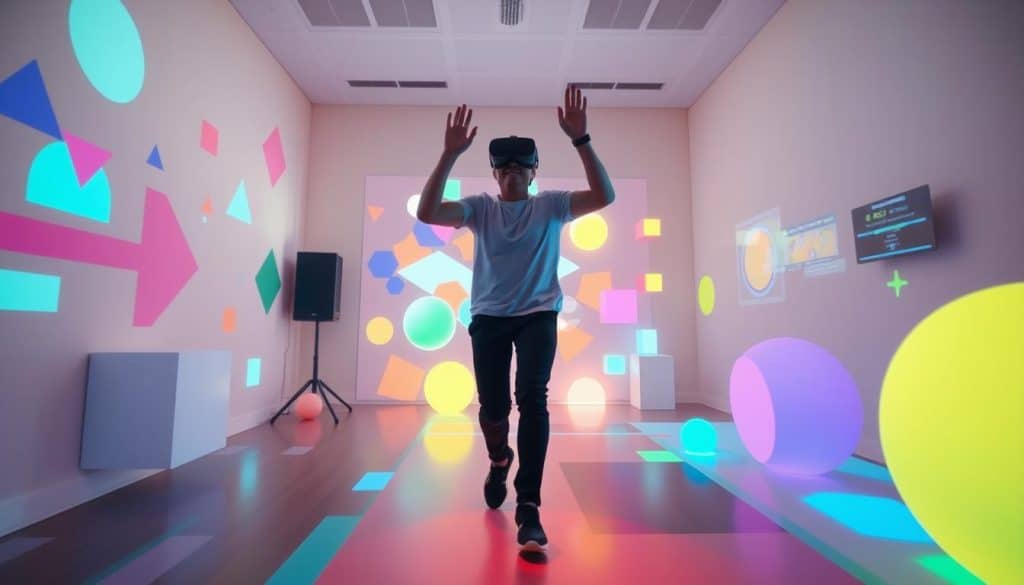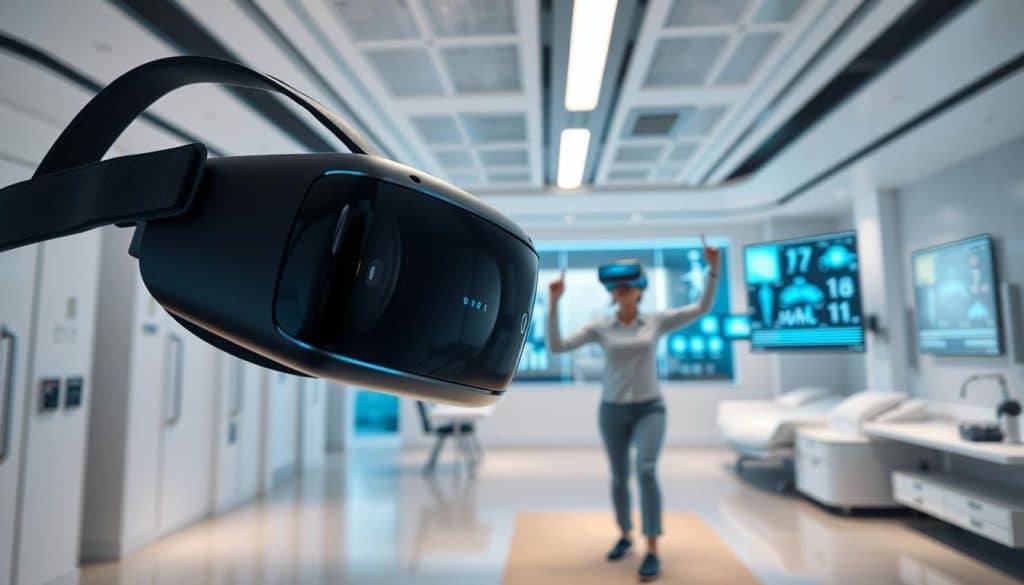Rehabilitation programs are getting a big boost from virtual reality therapy. Riverside Sports Therapy in Calgary, AB, is leading the way. They use the latest tech to change how patients recover.
Doctors are finding new ways to use virtual reality to help patients heal. These systems create real-like experiences. They help patients in ways old methods can’t.
Virtual reality therapy is a big step forward in healthcare. It mixes digital fun with medical care. This lets doctors create better recovery plans for all kinds of patients.
Key Takeaways
- Virtual reality transforms traditional rehabilitation approaches
- Personalized treatment becomes more accessible through immersive technologies
- Enhanced patient engagement during recovery processes
- Innovative therapeutic techniques expand medical treatment options
- Potential for improved recovery rates and patient motivation
Understanding Virtual Reality Technology in Modern Healthcare
Virtual reality has changed how we treat patients, bringing new ways to care and help them recover. It’s a big step forward in how we treat people, making therapy more real and effective.

Doctors use the latest VR tech to create better treatment plans. These systems offer a new way to help patients that old methods can’t match.
Core Components of Medical VR Systems
Modern VR systems for rehab have key parts:
- High-resolution VR headsets with motion tracking
- Special sensors to track patient movement
- Interactive software for VR exercises
- Custom input devices for patient interaction
“Virtual reality transforms patient engagement by making rehabilitation both interactive and personalized.” – Dr. Sarah Mitchell, Medical Technology Researcher
VR Integration in Healthcare Facilities
Adding VR tech needs careful planning and training. Hospitals must teach staff how to use these tools well.
Putting VR into practice means looking at what patients need, the tech setup, and what goals are. Doctors and tech experts work together to create immersive VR therapy environments. These help patients get better and see better results.
With virtual reality, doctors can give patients more engaging and effective rehab. This leads to better recovery for patients.
The Evolution of Using Virtual Reality in Rehabilitation Programs
Virtual reality in rehab has changed a lot over the years. It started as simple tech and now helps in physical therapy. The first steps in using VR for rehab were in the late 1990s.
Key milestones in VR rehabilitation technology include:
- 1990s: Initial experimental VR systems in medical research
- 2000-2010: Development of more interactive rehabilitation platforms
- 2010-2020: Advanced motion tracking and personalized treatment programs
- 2020-Present: AI-integrated VR rehabilitation solutions
Studies showed VR can make rehab more fun and engaging. The first VR tools were simple, but now they offer complex, tailored treatments.
| Decade | VR Rehabilitation Advancement | Key Technologies |
|---|---|---|
| 1990s | Experimental Simulations | Basic Computer Graphics |
| 2000s | Interactive Training Platforms | Motion Sensors |
| 2010s | Personalized Treatment Programs | Advanced Motion Tracking |
| 2020s | AI-Integrated Rehabilitation | Machine Learning Algorithms |
Canadian medical places are leading in using new VR tech in rehab. This keeps getting better, making treatments more personal and effective for many patients.
Benefits of VR-Assisted Physical Therapy
Virtual reality therapy is changing how we do physical therapy. It uses digital experiences to help patients get better and stronger. This new way of therapy is exciting and effective.
When patients use virtual reality therapy, they get a mix of tech and care that’s just for them. It’s not like old-school therapy. It’s fun and interactive, making rehab a game.
Improved Patient Engagement and Motivation
Virtual reality therapy makes patients want to do their exercises. It turns rehab into games they enjoy. Here’s how it works:
- Gamified rehabilitation exercises
- Immersive visual environments
- Real-time performance feedback
- Personalized challenge levels
Real-time Progress Tracking and Assessment
Therapists get to see how patients are doing in real time. They can track movements and adjust plans as needed. This helps patients get better faster.
Customizable Treatment Programs
Every patient is different, and virtual reality therapy knows it. Therapists can make plans that fit each person’s needs. This tech allows for:
- Tailored exercise difficulty
- Targeted muscle group training
- Progressive difficulty scaling
- Comprehensive performance analysis
The future of rehab is all about tech and care that’s just for you. Virtual reality therapy is at the forefront of this change.
Virtual Reality Applications in Neurological Rehabilitation

Virtual reality has changed how we treat neurological conditions. It’s making a big difference for patients with stroke, brain injuries, and Parkinson’s disease. VR exercises are now a key part of their treatment.
VR creates worlds that engage and help the brain. It makes therapy more fun and effective. This is a big step forward from old methods.
- Balance and coordination training using interactive VR scenarios
- Fine motor skill development through precise virtual interactions
- Cognitive function improvement via specialized mental exercises
- Personalized rehabilitation programs tailored to individual patient needs
Studies show VR helps patients get better faster. It lets doctors see how well patients are doing. This helps them make better plans for treatment.
| Neurological Condition | VR Rehabilitation Benefits | Key Improvement Areas |
|---|---|---|
| Stroke Recovery | Enhanced motor skill retraining | Limb movement, spatial awareness |
| Traumatic Brain Injury | Cognitive function restoration | Memory, attention, problem-solving |
| Parkinson’s Disease | Movement and balance improvement | Gait training, muscle coordination |
Virtual reality is not just a technological innovation but a game-changing approach to neurological rehabilitation, bringing hope and better recovery paths for patients with various neurological conditions.
Immersive VR Therapy Environments for Pain Management
Virtual reality therapy is changing how we manage pain. It offers new ways to treat pain that are different from old methods. These virtual environments help doctors tackle chronic and acute pain with advanced technology.

Virtual reality therapy is great because it distracts from pain in fun ways. Patients find relief through several methods:
- Interactive digital environments that redirect mental focus
- Guided relaxation scenarios with calming visual landscapes
- Neurological engagement through immersive sensory experiences
- Personalized pain management programs
Pain Distraction Techniques Through Virtual Reality
Studies show virtual reality therapy is a big step forward in pain management. It works by engaging many senses at once. This helps block pain signals and makes patients feel better.
Clinical Studies on VR Pain Management
Recent studies highlight virtual reality therapy’s wide range of benefits. They show it can:
- Reduce how much pain patients feel
- Help patients use less pain medication
- Boost patients’ mental health
- Make patients more involved in their treatment
Immersive VR therapy environments are a game-changer for pain management. They offer hope and relief to those with chronic and acute pain.
Gamified VR Rehabilitation: Enhancing Patient Experience

Gamified VR rehab changes the way we think about therapy. It turns boring exercises into fun, interactive games. This makes recovery a positive experience for patients.
This method is great because it makes therapy fun. Patients no longer see exercises as boring. Instead, they enjoy the challenge of virtual games.
- Interactive gameplay that tracks patient progress
- Customizable difficulty levels for personalized rehabilitation
- Real-time feedback and performance metrics
- Increased patient engagement and motivation
Doctors are seeing big improvements with VR therapy. It lets them track movements closely. This helps them tailor exercises to meet each patient’s needs.
Key benefits include improved motor learning, enhanced cognitive engagement, and a more positive emotional experience during recovery. Patients see their tasks as exciting challenges, not just medical routines.
Virtual reality transforms rehabilitation from a clinical necessity into an immersive, enjoyable journey of recovery.
Virtual Reality in Cognitive Rehabilitation and Mental Health
Virtual reality cognitive rehabilitation is a new way to tackle mental health issues. Therapists use digital worlds to help patients with different mental health problems.
VR exposure therapy is a strong tool for treating mental health disorders. It lets patients face and deal with traumatic experiences in a safe virtual space. This helps reduce anxiety and aids in healing.
Treatment of PTSD and Anxiety Disorders
Now, mental health experts use VR to help with PTSD and anxiety. The tech lets patients slowly face scary situations in a controlled way:
- Controlled environment for trauma processing
- Customizable exposure levels
- Real-time therapeutic intervention
- Reduced risk of overwhelming emotional responses
Memory and Attention Training Applications
VR therapy also boosts brain functions. It offers programs that make memory and attention skills better through fun, interactive games.
- Neuroplasticity stimulation
- Personalized cognitive training
- Objective performance tracking
- Adaptive difficulty levels
These new methods show how virtual reality can change mental health care. They offer hope and effective treatments for those seeking help.
Implementation of VR Telerehabilitation Services

Virtual reality telerehabilitation is changing how we get healthcare. It breaks down barriers and makes therapy more accessible. Now, patients in far-off or hard-to-reach places can get top-notch care from home.
To start using virtual reality in therapy, careful planning is key. Healthcare teams need to think about a few important things. This ensures the service works well:
- Strong internet connection
- Easy-to-use VR gear
- Safe way to send patient data
- Good technical help
The main benefits of virtual reality telerehabilitation are:
- More people can get therapy
- Less money spent on travel
- Tracking treatment progress better
- Patients are more involved
Getting virtual reality therapy to work right takes teamwork. Healthcare pros, tech experts, and patients all need to work together. The aim is to make therapy that’s easy to use and helps patients get better.
| Implementation Aspect | Key Considerations |
|---|---|
| Technology Selection | High-resolution VR headsets, responsive motion tracking |
| Patient Training | Comprehensive onboarding, technical support |
| Data Management | HIPAA-compliant platforms, secure data encryption |
As virtual reality telerehabilitation grows, healthcare in Canada is seeing its big impact. It’s changing therapy in many medical fields.
Safety Considerations and Best Practices in VR Therapy
Virtual reality therapy is changing how we treat patients. It brings new ways to help people get better. But, keeping patients safe is key when using VR therapy. Doctors need to watch out for risks and make plans to avoid problems.
Using VR therapy needs careful planning. Doctors must think about who will benefit most from it. They look at many things before suggesting VR therapy.
Patient Selection Guidelines
Choosing the right patients for VR therapy is important. Here’s what doctors do:
- Look at the patient’s health history
- Check their physical and brain abilities
- Find out if there are any reasons they shouldn’t use VR
- See if they can handle the technology
Managing Possible Side Effects
VR therapy can cause some issues. But, doctors can handle them:
| Potential Side Effect | Management Strategy |
|---|---|
| Motion Sickness | Start slow, keep sessions short |
| Eye Strain | Take breaks, adjust the headset |
| Disorientation | Have someone watch, use support |
Doctors make plans for each patient to stay safe and comfortable. They watch them closely and change plans if needed. This way, VR therapy can help patients without causing harm.
Having a doctor there and tailoring care is key to making VR therapy work.
Cost-Effectiveness of VR Rehabilitation Programs
Virtual reality rehabilitation programs are changing healthcare by making treatments more affordable. They use Virtual Reality in Rehabilitation Programs to cut down healthcare costs. At the same time, they improve patient results.
The cost of starting VR technology might look high at first. But, the long-term savings are big. VR exercises can make treatments shorter and reduce the need for expensive in-person therapy.
- Reduced therapy equipment costs
- Lower patient transportation expenses
- Decreased staff overhead
- Improved patient recovery rates
Studies show big economic benefits for hospitals using VR rehabilitation.
| Cost Factor | Traditional Therapy | VR Rehabilitation |
|---|---|---|
| Average Session Cost | $150 | $75 |
| Equipment Investment | $10,000/year | $15,000/year |
| Patient Recovery Time | 12-16 weeks | 8-10 weeks |
VR rehabilitation technology offers a scalable solution that optimizes healthcare resources while delivering personalized patient experiences.
As healthcare looks for new ways to save money, Virtual Reality in Rehabilitation Programs is a key solution. It balances being effective in treatment with being affordable.
Future Trends in VR Rehabilitation Technology
The world of virtual reality in healthcare is changing fast. It’s bringing new ways to help patients get better. New technologies are changing how doctors treat and help patients recover.
New technologies are making VR therapy better. They’re making treatment more effective and improving patient experiences.
Innovative Integration of Advanced Technologies
- Haptic feedback systems providing realistic sensory experiences
- Brain-computer interfaces for enhanced neural rehabilitation
- Artificial intelligence-driven personalized therapy protocols
- Advanced eye-tracking for precise movement assessment
Research and Development Directions
The future of VR therapy is getting more advanced. Researchers are working on making therapy smarter and more tailored to each patient. They aim to help with many health issues using smart systems.
| Technology | Potential Impact | Current Development Stage |
|---|---|---|
| AI-Enhanced VR Exercises | Personalized rehabilitation protocols | Advanced prototype |
| Neural Interface VR | Direct brain-controlled rehabilitation | Experimental research |
| Immersive Sensory Feedback | Enhanced patient engagement | Rapid development |
Hospitals are putting a lot of money into VR therapy. They want to make treatment more detailed and tailored to each patient. The mix of brain science, AI, and VR is opening up new ways to help people get better.
Success Stories from Riverside Sports Therapy
Riverside Sports Therapy in Calgary, AB, is leading the way in virtual reality therapy. They’ve changed how patients recover, with amazing results. Their use of VR in physical therapy has made a big difference for many patients.
Their success stories show how virtual reality therapy can change lives. Patients have seen big improvements in:
- Recovery speed and accuracy
- Engagement during rehabilitation
- Motivation to complete therapy sessions
- Precision of movement tracking
One patient, a professional athlete, recovered from a serious knee injury faster. They used VR-assisted physical therapy, which helped them regain full mobility 30% quicker than usual methods. The virtual environments allowed for specific exercises that helped the athlete’s recovery.
“Our VR technology enables us to create personalized rehabilitation experiences that traditional methods cannot match,” says Dr. Emily Roberts, lead physiotherapist at Riverside Sports Therapy.
The clinic is always looking to improve virtual reality therapy. They’re always finding new ways to help patients. This makes Calgary a center for new medical treatments.
Getting Started with VR Rehabilitation in Calgary
Riverside Sports Therapy in Calgary is leading the way in rehabilitation with Virtual Reality. Patients can try new VR exercises that mix technology with care. This approach changes how we recover.
Starting VR therapy begins with a detailed check-up. You’ll get a thorough talk about what you need. Then, we’ll pick the best VR therapy for you.
- Initial consultation and assessment
- Personalized VR rehabilitation plan development
- Tailored VR rehabilitation exercises
- Ongoing progress tracking
Our programs help with many needs, like brain recovery or sports injuries. The immersive VR environments make treatment fun. They help patients stay motivated and recover faster.
| Program Type | Conditions Addressed | Duration |
|---|---|---|
| Neurological Rehabilitation | Stroke Recovery, Brain Injury | 8-12 weeks |
| Sports Injury Recovery | Orthopedic Injuries, Joint Rehabilitation | 6-10 weeks |
| Cognitive Rehabilitation | Memory Training, Attention Disorders | 10-14 weeks |
Want to try VR therapy? Contact Riverside Sports Therapy today:
- Phone: (403) 283-7551
- Location: Calgary, AB, Canada
- Email: info@riversidesportherapy.ca
Discover the future of rehabilitation through innovative Virtual Reality technology at Riverside Sports Therapy.
Conclusion
Virtual reality therapy is changing healthcare rehabilitation. It uses new tech to help patients recover better. This tech makes treatment more fun and effective than old methods.
Riverside Sports Therapy in Calgary is leading the way. They use VR to make treatment more personal and engaging. This helps patients recover faster and feel more motivated.
VR therapy is becoming a key part of healthcare. It lets doctors track progress and give feedback right away. It’s a big step forward in making treatment better for everyone.
The future of rehab is all about digital, immersive care. VR therapy brings hope and new ways to heal. It’s making recovery better, faster, and more focused on the patient.
